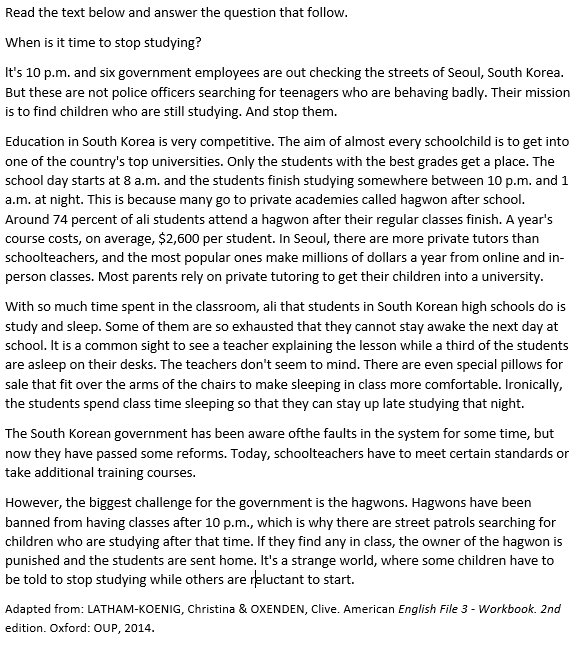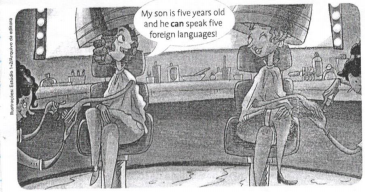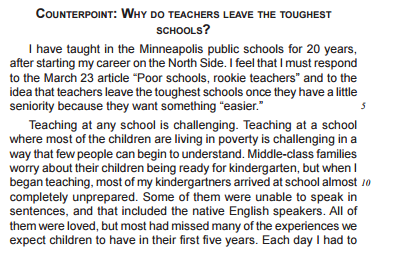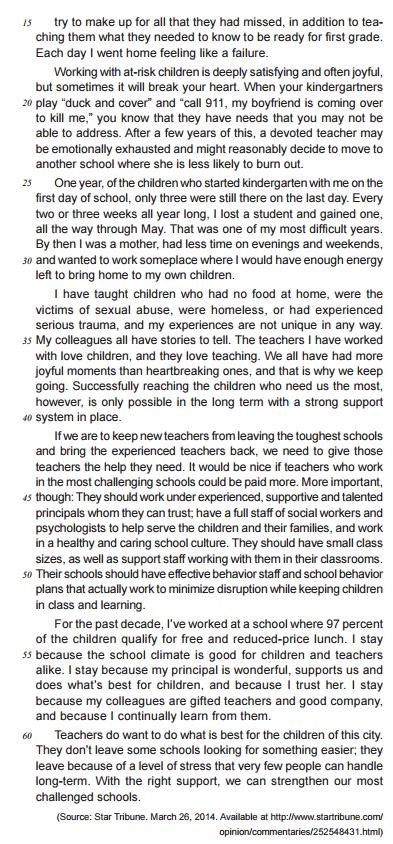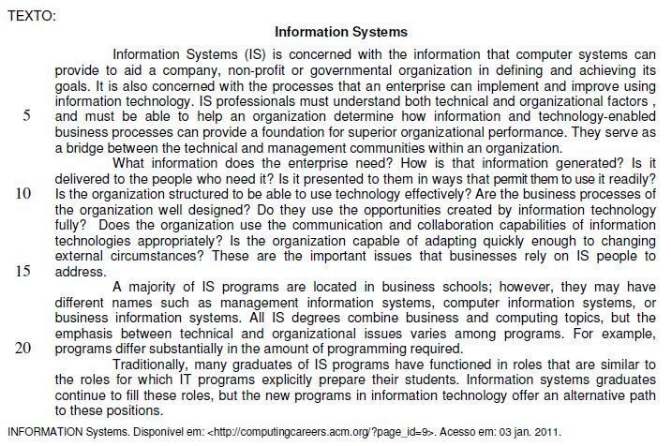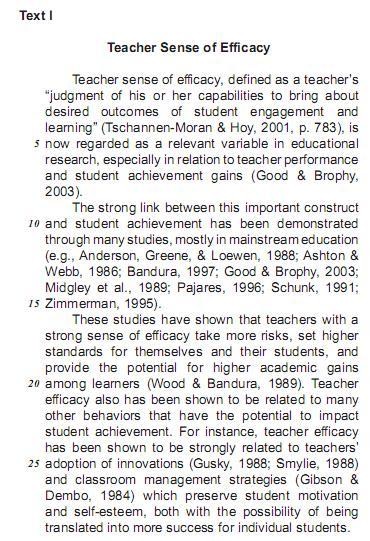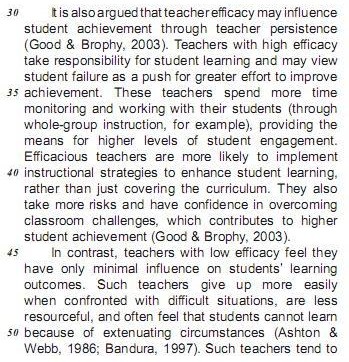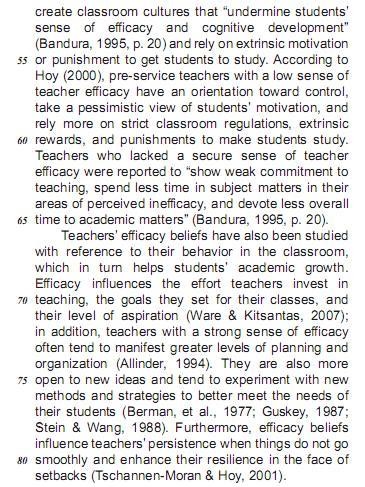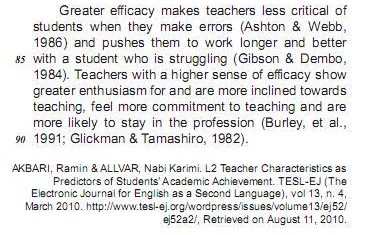In the sentence "South Korean students mustn't sleep in the classroom", the modal verb MUSTN'T in this context indicates:
Choose the option that correctly completes the sentence: “Rose starts work at 6 a.m.
Choose the idea expressed by the modal verb in the picture: Choose the correct alternative to complete the senteces.
Check the meaning of the modal verb in the sentence “He may go to the beach if he doesn’t have to work”.
“________ the variety of school structures and services at each location, I decided that the classrooms of focused study _______ have similar characteristics to facilitate comparison between sites and potential transferability of information gleaned to the typical age of children in most preschools."
Choose the correct option to complete the sentence according to the context.
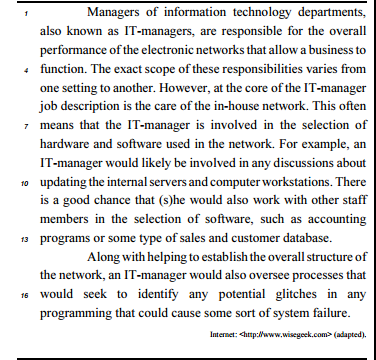
In the text about IT-managers, the word
“could” (R.17) can be replaced by can without any change in the meaning of the text.
TEXT 3
Sustainable mining – oxymoron or a way of the future?
Mining is an activity that has persisted since the start of humans
using tools. However, one might argue that digging a big hole in
the ground and selling the finite resources that come out of that
hole is not sustainable, especially when the digging involves the
use of other finite resources (i.e. fuels) and produces a lot of
greenhouse gases.
The counter argument could go along the lines that minerals are
not being lost or destroyed through mining and mineral
processing – the elements are being shifted around, and
converted into new forms. Metals can even be extracted from
waste, seawater or even sewage, and recycled. But a more simple
argument is possible: a mine can be sustainable if it is
economically, socially and environmentally beneficial in the short
and long term. To be sustainable, the positive benefits of mining
should outweigh any negative impacts. […]
Social positives are often associated with mines in regional areas,
such as providing better amenities in a nearby town, or providing
employment (an economic and social positive). Social negatives
can also occur, such as dust, noise, traffic and visual amenity.
These are commonly debated and, whilst sometimes
controversial, can be managed with sufficient corporate
commitment, stakeholder engagement, and enough time to work
through the issues. Time is the key parameter - it may take
several years for a respectful process of community input, but as
long as it is possible for social negatives to be outweighed by
social positives, then the project will be socially sustainable.
It is most likely that a mine development will have some
environmental negatives, such as direct impacts on flora and
fauna through clearing of vegetation and habitat within the mine
footprint. Some mines will have impacts which extend beyond
the mine site, such as disruption to groundwater, production of
silt and disposal of waste. Certainly these impacts will need to be
managed throughout the mine life, along with robust
rehabilitation and closure planning. […]
The real turning point will come when mining companies go
beyond environmental compliance to create 'heritage projects'
that can enhance the environmental or social benefits in a
substantial way – by more than the environmental offsets
needed just to make up for the negatives created by the mine. In
order to foster these innovative mining heritage projects we need
to promote 'sustainability assessments' - not just 'environmental
assessments'. This will lead to a more mature appreciation of the
whole system whereby the economic and social factors, as well as
environmental factors, are considered in a holistic manner.
(adapted from https://www.engineersaustralia.org.au/westernaustralia-division/sustainable-mining-oxymoron-or-way-future.
Retrieved on August 10, 2015)
The excerpt “one might argue” (l.2) expresses:
Modal verbs can be classifi ed into two major categories of meaning: epistemic and deontic. Epistemic modals refer to the logical status of events or states. The following alternatives are examples of epistemic modals. The only exception is:
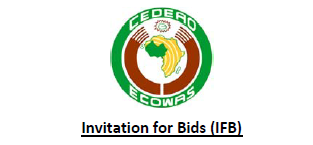
1. The ECOWAS COMMISSION has allocated own funds towards the cost of the Supply, Deployment & Installation of Network Equipment at the ECOWAS Commission Headquarters Data Centre, Abuja.
2. The ECOWAS Commission therefore invites sealed bids for the Supply, Deployment & Installation of Network Equipment at the ECOWAS Commission Headquarters Data Centre, Abuja described above in one lot.
3. The Bidding Document can be obtained at the Procurement Division, Directorate of General Administration, ECOWAS Commission, Plot 101, Yakubu Gowon Crescent, Asokoro District, Abuja, Nigeria, upon submission of a written request and payment of three hundred US Dollars (US$300.00) by Cash or Bank Draft made in favour of ECOWAS Commission, Abuja.
4. For Bidders outside Nigeria, the Bidding Document can be mailed to interested Bidders upon payment (by Transfer) of non‐refundable fee of US$300.00 to the Commission (transfer charges born by the bidder). (Account Details available on request.)
5. Interested Bidders may obtain further information at the address below, during office hours: Monday to Friday from 9.00am (8.00am GMT+1) to 4.00pm (3.00pm GMT+1), ECOWAS Commission, Directorate of General Administration, Procurement Division, 1st Floor, Plot 101, Yakubu Gowon Crescent, Asokoro District, PMB 401 Abuja Nigeria.
E‐mail: [email protected]
6. Bids shall be valid for a period of 120 (days) after Bid Opening and must be accompanied by a bid security of US$20,000.00 (Bank Guarantee or Insurance Bond).
7. Bids shall be delivered in sealed envelope and deposited in the ECOWAS Tender Box located Office of the Executive Assistant of Commissioner of Administration & Finance, fifth (5th) floor of the ECOWAS Commission Building, 101, Yakubu Gowon Crescent Asokoro District, P. M. B. 401, Abuja, Nigeria on or before November 7, 2013 at 11.30am (10.30am GMT+1) and clearly marked “International Competitive Bidding for the Production of ECOWAS Biometric Laissez Passer and Supply of Equipment” Do Not Open, Except in Presence of the Committee.
8. Bids will be opened in the presence of the bidders who wish to attend on November 7, 2013 at 12.00 noon (11.00am GMT+1), Room 523, Ecowas Commission, Abuja, Nigeria.
(The Economist, September 4th, 2013. Page 86. Adaptado.)
A bid security
Procedural programming has been around since the
inception of computers and programming. Object–oriented
paradigms arrived a little later — in the late 1950s to early 1960s
— which means over 50 years of object–oriented problem solving.
Still, many developers lack a full understanding of the thought
process in developing object–oriented software and therefore can't
take advantage of its concepts. I'm happy to see that this book, The
Object–Oriented Thought Process, has taken this fairly old
perspective and given it full attention and renewed interest.
Not having read the previous editions, I'm not familiar
with the changes represented in this fourth edition. Author Matt
Weisfeld is a professor who understands these important concepts
and the level of knowledge and process required for readers and
students to grasp what they need to know. The examples in the book
are concise, clear, and easy to follow. Additionally, the book makes
good use of white space, lists, pictures, and diagrams to make the
content easier to follow and scan quickly.
Weisfeld has organized the concepts to build on each
other, ensuring that students understand one concept well before
moving to the next. On the other hand, readers who already
understand the fundamentals can go directly to object–oriented
thought processes for particular programming paradigms, such as
Web services or client–server applications.
The book is language–neutral. Its examples are in C#, but
a supplementary website offers example code in other languages. If
your language isn't fairly represented, don't be deterred from
acquiring this book because object–oriented concepts and semantics
are mostly universal — just the particular implementation might
vary due to the language.
Each chapter contains UML and example code to better
understand the concepts and see how they're implemented. The last
chapter introduces design patterns but without going into great
detail about how to use them. This lets the inexperienced reader
know that design patterns would be the next step in the path to
developing good code.
Overall, I can recommend this book to code developers,
designers, and testers — to anyone with an interest in proper
software development semantics. It's available in a digital format
that serves as a useful ready reference.
Scott Brookhart. Thinking about objects.
Internet:
Considering the book review above, judge the following items.
The digital format of the book will be launched soon.
DIRECTIONS: Choose the CORRECT alternative to
answer questions 16 to 25.
Questions 16 to 20: Choose the CORRECT alternative to
answer questions 16 to 20, according to TEXT 01.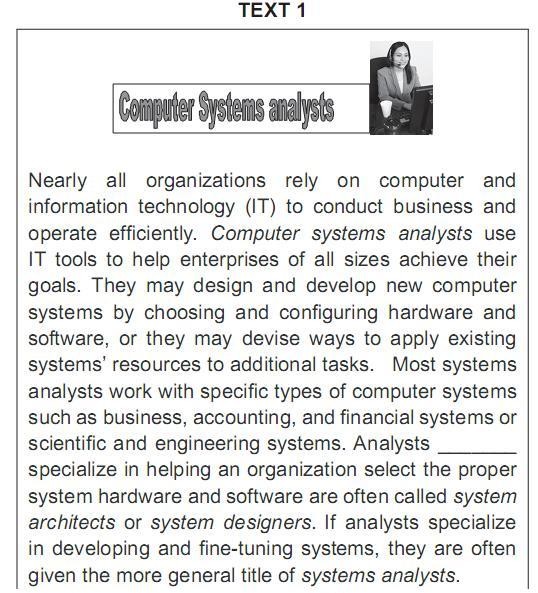
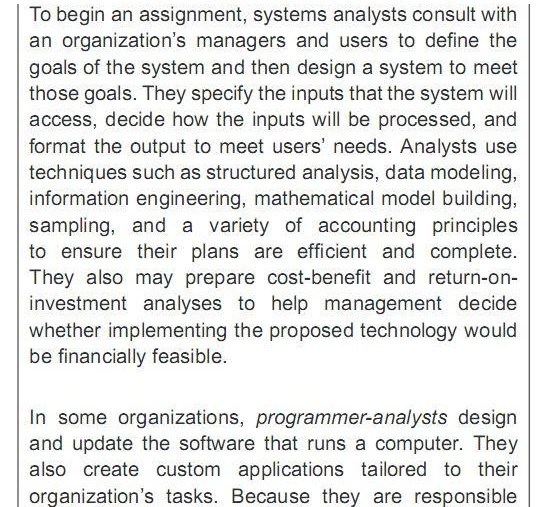

Question 25: Choose the CORRECT alternative to answer question 10, according to TEXT 04.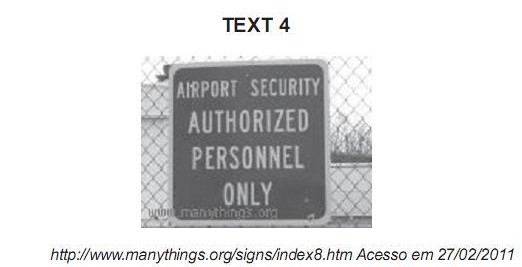
You leave the supermarket and go straight to Heathrow to meet an old friend of yours. But at the entrance, you find the above sign which means you _____ enter.
In the sentence IS professionals must understand both technical and organizational factors (linha 4), one can say that the modal verb
Ten Tips for Microsoft Word and Excel
Our latest tips tell you how to make Microsoft Office 2010's word
processor and spreadsheet apps perform some handy tricks that
Microsoft has documented poorly.
By Edward Mendelson
PCMag.com's Microsoft Office 2010 tips collection
continues, this time with ten tips for Word and Excel users. Most
of these tips are fairly straightforward, and most apply to the
most recent versions of Office. Some of them, however, offer
new twists for the latest version of Office. Expert users will be
familiar with some of these ten tips, but we hope that any user
will find at least a few of these to be useful.
What kind of tips am I talking about this time? Finding
ways to perform poorly documented functions in Word and
Excel. One of these tips, for example, tells you what to do when
Word inserts a horizontal line across the page when you only
wanted to type a few dashes. In the past few months, everyone
in my family has tried and failed to wrestle an unwanted
horizontal line out of a Word document. It might not sound like a
big issue, but once you've got it in your document, good luck
finding help from Microsoft on how to get rid of it.
Some software vendors, like Adobe, continue to provide
help systems that work like improved versions of traditional
software manuals. In those apps, every menu item, every
toolbar icon, is carefully explained, and with a little patience you
can find all the information you need. Microsoft,  provides
provides
you with a kind of information supermarket, with huge essays
about topics you don't care about, dozens of selections when
you only need one, and no consistent way to find the information
you want.
Combine Portrait and Landscape Pages in a Word Document
Microsoft Word expects you to organize your documents
in a highly-structured but not very intuitive way. If you want to
format most of a document in portrait mode, but one or two
pages in landscape, you  simply change the orientation
simply change the orientation
of the current page. Instead you need to insert a section break
before and after the text you want to format in landscape mode,
and then apply landscape orientation to the section that you
created. Place the insertion point at the point where you want
landscape orientation to begin. On the Page Layout tab, choose
Breaks, then, under Section Breaks, choose New Page. Then
move the insertion point to the end of the text you want to format
in landscape, and insert the same kind of break. Then put the
insertion point anywhere between the two breaks; return to the
Page Layout tab, and click the down-pointing arrow at the lower
right of the Page Setup group. In the Page Setup dialog, on the
Margins tab, selectLandscape orientation, then go to the "Apply
to" dropdown and select This Section.
(Adapted from http://www.pcmag.com/article2/0,2817,
2379207,00.asp#)
O verbo que preenche corretamente a lacuna [modal] é
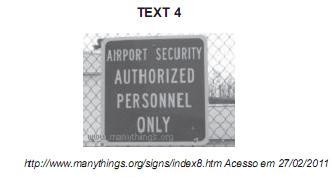
You leave the supermarket and go straight to Heathrow to meet an old friend of yours. But at the entrance, you f nd the above sign which means you _____ enter.
In It is also argued that teacher efficacy may influence student achievement through teacher persistence (lines 30-31), the modal auxiliary may expresses

